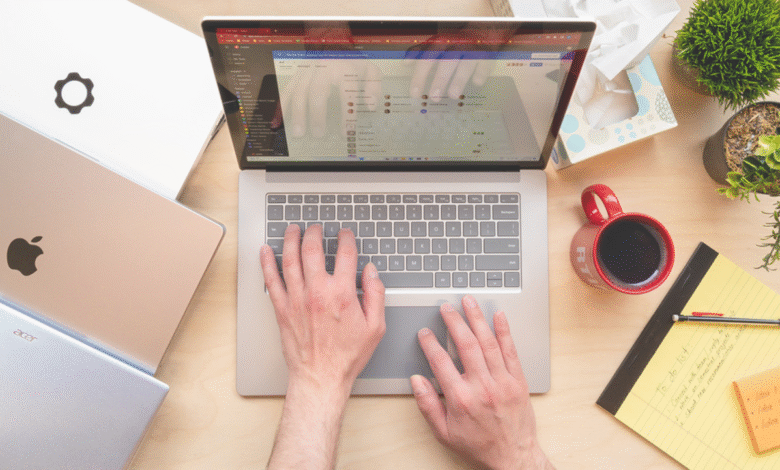How to Choose the Right Laptop for Remote Work in 2025
Right Laptop for remote work 2025 Ultimate guide to choosing powerful secure laptops for hybrid work. Compare specs and future-proof features

Choosing the Right Laptop for remote work in 2025 is more important than ever as hybrid and fully remote roles continue to dominate the workforce. With rapid advancements in AI, cloud computing, and collaborative tools, professionals need a device that delivers seamless performance, long battery life, and reliable connectivity. Whether you’re a digital nomad, a corporate employee, or a creative freelancer, selecting the Right Laptop requires careful consideration of processing power, portability, display quality, and security features to ensure productivity from anywhere in the world.
The ideal remote work Right Laptop in 2025 should strike a balance between power and mobility while being future-proof enough to handle evolving software demands. From ultraportable business notebooks to high-performance workstations, this guide will explore the key factors including processors, RAM, battery efficiency, and security to help you make an informed decision. By understanding these essential aspects, you can invest in a laptop that enhances efficiency, supports multitasking, and adapts to the ever-changing landscape of remote work.
Key Factors to Consider When Choosing a Remote Work Laptop in 2025
Performance and Processing Power
A Right Laptop performance hinges on its processor, RAM, and storage. In 2025, remote workers should opt for at least an Intel Core i7 or AMD Ryzen 7 processor, as demanding applications like video conferencing, AI tools, and multitasking require robust processing power. For professionals in creative fields, such as graphic design or video editing, an Intel Core i9 or AMD Ryzen 9 with dedicated graphics (NVIDIA RTX or AMD Radeon) is ideal. Memory is equally crucial 16GB RAM is the baseline, but 32GB or more ensures smoother performance when running virtual machines or complex software.
Portability and Build Quality
Remote workers often switch between home offices, coworking spaces, and travel, making portability essential. A Right Laptop weighing between 2.5 to 3.5 pounds with a slim profile (under 0.7 inches) is ideal for mobility. However, durability matters just as much look for MIL-STD-810G certification or aluminum/magnesium alloy builds for long-term resilience.
Battery Life and Power Efficiency
A reliable battery is non-negotiable for remote work. In 2025, aim for a laptop with at least 10-12 hours of real-world usage. ARM-based processors (like Apple’s M-series or Qualcomm’s Snapdragon X Elite) offer excellent power efficiency, while Intel and AMD’s latest chips optimize battery life through advanced power management. Features like fast charging (0-80% in under an hour) add convenience for professionals on the go.
Display and Ergonomics
A high-quality display reduces eye strain during long work sessions. A 14-inch to 16-inch screen with at least Full HD (1920×1080) resolution is recommended, though 4K is preferable for designers. IPS or OLED panels provide better color accuracy and viewing angles. Additionally, anti-glare coatings and blue light filters (like TÜV-certified displays) enhance comfort. For ergonomics, a backlit keyboard and a responsive touchpad (or support for external peripherals) improve usability. Some Right Laptop now feature adjustable hinges or dual-screen setups, catering to multitasking needs.
Connectivity and Future-Proofing
Next-Gen Wireless Connectivity
Wi-Fi 6E ensures faster speeds (up to 9.6 Gbps) and less congestion in crowded networks. 5G/4G LTE cellular support keeps you connected anywhere without relying on public Wi-Fi.
Thunderbolt 4 & USB4 Ports
40Gbps data transfer speeds for external SSDs, docks, and 8K displays. Single-cable docking capability for streamlined home office setups.
Multiple Display Support
HDMI 2.1 for 4K@120Hz or 8K@60Hz external monitors. Dual 4K display support via Thunderbolt/USB4 for multitasking.
AI-Ready Hardware
NPUs (Neural Processing Units) in newer Intel Core Ultra and AMD Ryzen AI chips accelerate AI tasks. Dedicated Copilot/ML keys on keyboards for quick Artificial intelligence assistant access.
Modular & Upgradeable Designs
User-replaceable RAM/storage (Framework, some business laptops) extends lifespan. External GPU support via Thunderbolt for future graphics upgrades.
Universal Charging Standards
USB-C PD 3.1 supports up to 240W charging for Right Laptop and peripherals. MagSafe-like solutions (Dell’s ExpressCharge, Lenovo’s Slim Tip) for safer charging.
Software Ecosystem Compatibility
Windows 11/Arm support for better efficiency and app emulation. Linux certification if you work with open-source tools.
Security and Privacy Features
Biometric Authentication
Fingerprint scanners and Windows Hello facial recognition provide faster, more secure logins than passwords alone. Apple’s Touch ID/Face ID on MacBooks ensures seamless yet protected access.
Hardware-Based Encryption
TPM 2.0 chips (Trusted Platform Module) encrypt sensitive data, mandatory for Windows 11. Apple’s T2/Security Chip (or newer) secures storage and firmware on Macs.
Physical Privacy Protections
Webcam shutters or kill switches prevent unauthorized camera/mic access. Privacy screens (like HP Sure View) limit screen visibility to shoulder surfers.
Enterprise-Grade Security
Intel vPro or AMD Pro processors offer remote management and threat detection for businesses. Kensington lock slots deter theft in public workspaces.
Software and Network Security
Pre-installed VPNs or VPN compatibility for secure public Wi-Fi use. Built-in malware protection (Windows Defender, macOS Gatekeeper) and zero-trust firmware (like Microsoft Pluton).
Budget and Value for Money
Define Your Needs vs. Wants
Remote work demands vary basic office tasks (emails, documents) require less power than video editing or software development. Prioritize specs that match your workload to avoid paying for unnecessary upgrades.
Premium vs. Mid-Range
High-end laptops (MacBook Pro, Dell XPS) offer top-tier performance and build quality but come at a premium. Ideal for creatives or power users. Mid-range options (ASUS ZenBook, HP Envy) provide excellent performance for general remote work at a lower cost. Budget-friendly picks (Acer Swift, Lenovo IdeaPad) suit light tasks but may lack longevity for intensive use.
Refurbished and Business-Grade Alternatives
Certified refurbished laptops (like Apple’s refurbished store) or enterprise models (Lenovo ThinkPad, Dell Latitude) offer durability and higher specs at reduced prices. Look for warranties to ensure reliability.
Future-Proofing vs. Short-Term Savings
Spending slightly more on upgradable RAM/storage or newer processors can extend your Right Laptop lifespan, saving money on premature replacements.
Hidden Costs to Consider
Accessories Docking stations, external monitors, or ergonomic keyboards add to expenses. Software subscriptions: Some OS or productivity tools require ongoing payments. Repairs/upgrades: Non-upgradable models may cost more long-term.
Seasonal Deals and Corporate Discounts
Timing purchases around sales (Black Friday, back-to-school) or leveraging employer/student discounts can significantly lower costs without compromising quality.
Read More: How Small Businesses in the U.S. Can Grow With SEO
Conclusion
Selecting the Right Laptop for remote work in 2025 requires careful consideration of performance, portability, and future-proof features that align with your professional needs. As remote and hybrid work models continue to evolve, your Right Laptop should not only handle daily productivity tasks but also adapt to emerging technologies like AI-powered applications, advanced video conferencing, and cloud-based workflows. By prioritizing key aspects such as processing power, battery longevity, display quality, and security, you can ensure seamless efficiency no matter where you work.
Ultimately, the Right Laptop for remote work in 2025 should empower you to stay productive, connected, and competitive in a digital-first world. Whether you’re a frequent traveler, a creative professional, or a corporate employee, investing in a device that balances performance with durability will help you navigate the demands of modern remote work with ease. Keep these factors in mind, and you’ll find a Right Laptop that not only meets your current needs but also supports your career growth in the years to come.
FAQs
What is the Right Laptop for remote work in 2025?
For most professionals, an Intel Core i7 or AMD Ryzen 7 is sufficient. Creatives and developers may benefit from an i9 or Ryzen 9.
How much RAM do I need for multitasking?
16GB is standard, but 32GB is recommended for heavy multitasking, virtual machines, or advanced software.
Are 5G laptops worth it for remote work?
Yes, if you frequently work on the go without reliable Wi-Fi. Otherwise, Wi-Fi 6E is more cost-effective.
What screen size is best for productivity?
14-16 inches offers a balance between portability and workspace. Larger screens benefit designers and coders.
How important is battery life for remote work?
Critical aim for at least 10-12 hours to avoid frequent charging during workdays.











